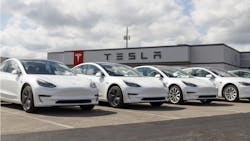EV Industry Roundup: Sales Growing Slowly but Surely
Download this article in PDF format.
As consumers gravitate toward electric vehicles (EVs) for their environmental benefits, lower operating costs, zero emissions and other positive features, the EV sector as a whole is evolving, maturing and growing. And while EV sales in 2023 are being impacted by lower consumer spending, recessionary fears and high interest rates, the EV sector’s potential continues to look bright as the related technology improves and as consumers make more environmentally-friendly choices.
According to CBT News, the nation’s EV inventory increased during the second quarter of 2023, effectively “dwarfing” suppliers of gas-powered cars. The average days’ supply of electric vehicles totaled 92 days during the quarter, more than twice the amount seen in mid-2022 and 80% higher than the industry average of 51 days.
“On a weekly basis, dealers held roughly 92,000 EVs in stock across the U.S., a 342% increase over the previous year’s 21,000,” the publication adds. Ample supply of materials and components have helped speed up greater factory output for EV automakers this year. And new EV-focused incentives for consumers and manufacturers have also helped boost confidence in the segment.
“However, despite this sizeable boost in production and popularity, the distance between demand and supply continues to grow,” CBT News adds, noting that EV affordability remains an obstacle for many consumers, even as more buyers express enthusiasm for the technology.
A Slow-but-Steady Shift
Growing demand for electric vehicles underscores an industry-wide shift away from gas-powered cars, the Washington Post reports. “Consumers are not shying away from electric vehicles…in fact, it’s quite the opposite,” Wedbush Senior Analyst Dan Ives told the publication. “Tesla’s blockbuster results show roughly an 83 percent increase from a year earlier. We’re seeing a green tidal wave of demand playing out.”
The growth of pure play EV manufacturers could lead to a “much bigger industry transformation, as traditional automakers reprise well-known brands as all-electric models,” the Washington Post adds.
For example, Dodge recently retired its gas-powered Charger and Challenger in favor of battery-powered cars that imitate their predecessors’ “classic roar” and Ford now offers an all-electric F-150 pickup.
Supply and Demand Mismatch
In “Unsold electric cars are piling up on dealer lots,” Axios’ Joann Muller says there simply aren’t enough buyers for the number of available EVs right now. “The growing mismatch between EV supply and demand is a sign that even though consumers are showing more interest in EVs, they're still wary about purchasing one because of price or charging concerns,” Muller writes.
Some brands are seeing higher EV inventories than others. For example, Genesis sold only 18 of its Electrified G80 sedans in June. The company had 210 of the vehicles in stock nationwide.
Imported models like the Kia EV6, Hyundai Ioniq 5 and Nissan Ariya are also stacking up, Muller adds, likely because buyers of these foreign-made vehicles aren’t eligible for tax credits.
More EV Batteries Needed
Looking ahead, Reuters says Panasonic’s battery arm plans to build four more factories to reach its target for a “sharp boost” in annual capacity of batteries for EVs by 2031. Panasonic Energy aims to boost annual EV capacity to 200 gigawatt hours (GWh) by early 2031, or about four times the capacity it reported having in March 2023.
With a current plant in Nevada, Panasonic is building a second in Kansas that is expected to take annual capacity to 80 GWh once operational. The company is focusing on North America to build up capacity for production of 4680 batteries, the newest cells championed by Tesla.
Previously, Panasonic said it planned to build at least two new factories for 4680 production in North America by 2030, with Oklahoma pinpointed as a possible site. The four new plants will need to be supported by about a dozen factories of materials suppliers, the Washington Post reports.
About the Author

Bridget McCrea
Contributing Writer | Supply Chain Connect
Bridget McCrea is a freelance writer who covers business and technology for various publications.






